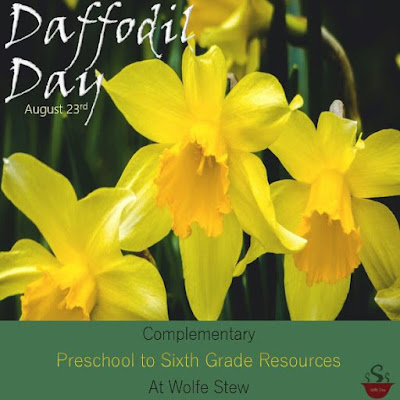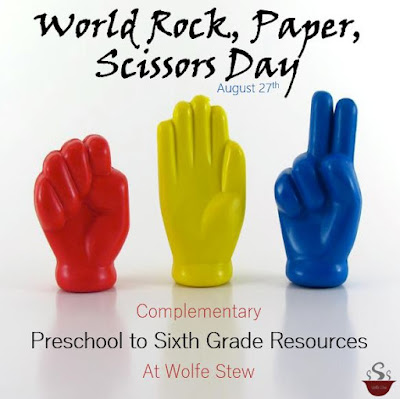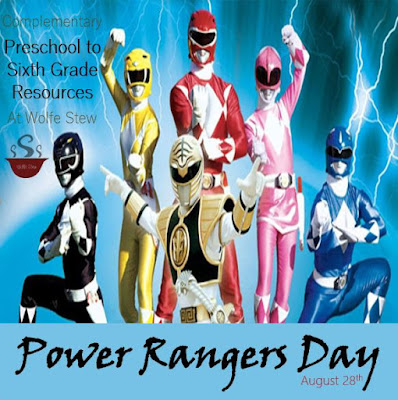August Week 4 | An Idea for Every Day
For me, it’s not me. It’s God. In the face of all this
uncertainty, I cling to my Rock – the one who has been and always will be
certain. I trust He’ll guide me through with His gentle hand and will restore
peace in my soul, both in daily snippets and eventually as a season. What about
you? How do you get through your uphill battles, your seasons of uncertainty?
We’d love to hear your method, if you’d care to share. Comment below or email us (mr OR mrs@wolfestew.com).
Please know, that if you, too, find yourself amid an uphill
battle or season of uncertainty, you’re not alone. We’re right there with you
and we’re pulling for you to get through it - just as we trust you’re likewise
rooting for us!
- Daffodil Day (Fourth Friday of August) - Crafts for learners and leaders, history
- Strange Music Day (August 24th Annually) - Music (developing preferences, analyzing, eras, world music, genres); Math (bar graphs; interpreting data)
- Banana Split Day (August 25th Annually) - History (inventions); Oral Communication (debate); Literacy (supporting opinions with textual details; following directions); Cooking; Art (communicate ideas); Math (measurement, counting, number recognition)
- Toilet Paper Day (August 26th Annually) - Social Studies (traditions, cultural perspective, tools, inventions, current events); Technology (meme generation, graphic design tools); Writing (informational, graphic features)
- World Rock, Paper, Scissors Day (August 27th Annually) - Reading (following directions); Social Studies (traditions, cultures); Writing (informational)
- Power Rangers Day (August 28th Annually) - Reading (answering questions, comprehension, drawing conclusions); Physical Fitness (exercise plan, exercise videos, nutrition planning) Writing (descriptions, character creation)
- Speak Kind Words Saturday (Last Saturday of August) - Biblical and secular activities and articles to encourage kindness in leaders and learners.
- August
Calendars (2020, 2021, 2022) – Ideas at a glance with clickable
links for you advanced planners.
- Weekly
Blog - You’re reading it now. 😊
- SUBSCRIBE by sharing your email in the field on the left side panel to
get them delivered directly to your inbox.
- Check
out the four latest posts (ideas never expire):
- Even
More Ideas – Look over our Pinterest board.
Fourth August Friday – Daffodil Day
 |
| Daffodil image by David Jakab via Pexels |
Yellow, white, pink, or orange, daffodils are cheerful flowers. While commonly celebrated in spring, we think they’re worthy of a day
in late summer too, especially considering their tendency to spread good cheer.
So, whether you buy a bouquet, check out pictures online, or complete one of
our stewed-upon activities, we do hope today your daffodil display adds cheer
to your life.
To bring daffodil cheer into your home, consider crafting
one. We discovered three variations in increasing levels of difficulty.
Wouldn’t it be fun to add this William Wordsworth quote
somewhere on your daffodil art?
Then my heart with pleasure fills and dances with the daffodils.
August 24th Annually – Strange Music Day
 | |
|
What’s strange to one is not necessarily strange to another;
“strange” is a relative term. And that’s the learning objective in these ideas
we’ve been stewing on for you.
- World Music at All Around this World. The link brings you to All Around this World’s “Listen” page where you’re invited to explore music sorted in lists by geographic region or displayed on an interactive map (which invites you to discuss the relative location of the music’s origin). This really is a treasure trove of resources. Each region has at least ten full length songs with videos (sometimes Jay, sometimes regional performers, and sometimes both) that sometimes are accompanied by actions, lyrics, and possibly additional lesson plans, but are always accompanied by a description. Check out this “Senzenina” page (from South Africa) as an example which has ALL of the above options available. While there are MANY free resources, Jay (the page owner) also offers an online class and livecasts. Even if you don’t want to engage in Strange Music Day, we HIGHLY recommend that if you’re teaching music to your kids at all, you check this site out!
- Eras of Music at Classics for Kids. At this link, you’ll find a musical timeline with a brief description of each musical era. Click the desired musical era link to learn more about the era, discover prominent era musicians, and (when available) listen to era music.
- Genres of Music at DK Find Out. DK Find Out offers an introduction to basic music genres including African Music, Blues, Celtic, Classical, Country, Dance, Gospel, Indian, Jazz, Pop, Reggae and Rock. You’ll learn when the genre emerged, a description of its distinct qualities, influences on the genre, and iconic genre musicians. Unfortunately, DK Find Out does not provide listening samples. We suggest browsing Pandora, Spotify or YouTube for each genre. The only trick here is making sure they are child appropriate. To be on the safe side, consider selecting a few options in each genre beforehand.
You’ve chosen the way you’ll browse music (by location, era or genre). Now, it’s time to start the exploration! Before listening to each song, write the title on a post-it note. Then, after listening, categorize the piece (based on your opinion) as “strange” or “not strange” by stacking sticky notes above the corresponding label to make a bar graph (how-to explained by Post-It.com). Discuss the qualities that justified the placement. Lead a discussion to help learners conclude that the exact qualities that make music “strange” to one might endear it to another.
“Let yourself be silently drawn by the strange pull of what you really love. It will not lead you astray.” - Rumi
August 25th Annually – Banana Split Day
 |
| Banana split image via pxfuel |
First, learn the history with American Profile. Did you know
there is actually a rivalry over who actually invented it? Neither did we.
Learn about it in this article. Consider having your learners choose a side and
debate or select details from the text that support their choice.
- You decide. Executive decision, and sometimes, leaders, you deserve to choose.
- Select one based on ingredients you have on hand.
- Let your learners choose their favorite and vote. If you have a large group, consider forming teams to craft arguments for their selection.
- Go with our choice. Our executive decision: the Banana Split Crepe Burritos courtesy of My Modern Cookery. Although, if I’m being honest, I’d totally be up for trying out all 15 of them.
Wrap-up by crafting and enjoying their planned banana split,
featuring that gentle curving smile of a fruit.
August 26th Annually – Toilet Paper Day
 |
| Toilet Paper image via pxfuel |
- Mental Floss Article – tells the history of toilet paper. Don’t judge; it’s interesting! We’re willing to bet you’ll even learn a thing (or two) about it. One (cringe-worthy) thing we learned: Romans used sponges and salt water. This fact certainly helps us appreciate toilet paper all the more.
- CNN Article – summarizes the toilet paper role in the time of COVID, for the learners who are unaware or need more details. While their work should include personal history, exposure to broader perspectives provides a deeper understanding of a topic. The article offers conjectures as to the cause of the toilet paper crisis, almost certainly a source of interesting infographic details.
- Imgflip – an online meme generation tool with a library of pictures from which your learners may choose. You choose the picture, write the text, then generate your meme. Meme generation is a fun way to implement technology for your younger learners! Just make sure to sit with them through the process, some images might be questionable. We didn't find any questionable ones when we tested it out, but they likely exist. If you'd rather error on the side of caution, explain what a meme is, show them a few samples, and have them draw their own.
- Canva – an online graphic design tool with many free resources. This links you directly to their infographic maker. Choose a template, then customize each text box. We’d recommend having learners complete a rough draft on paper before opening Canva, as it’s easy to lose sight of your goals with all the options Canva offers. When on Canva, have learners first focus on inputting the information, then altering customization.
August 27th Annually – World Rock, Paper, Scissors Day
 |
| Rock Paper Scissors image licensed under CC BY-SA-NC |
- Preschool to First Graders can draw a picture and write a description (with this template crafted for you by Wolfe Stew) to represent the fact they want to share.
- Second to Third Graders choose three related facts to write a complete paragraph about rock, paper, scissors. Print off your Wolfe Stew crafted draw and write paper here, if you’d like.
- Fourth to Sixth Graders challenge what you thought you already knew about rock paper scissors in a blog post, news video or social media post.
Did you know that this game, played worldwide, likely
originated between 206BC and 220AD? So, when you play rock, paper, scissors,
you’re engaging in a long-standing tradition. We’d love to know, are you a rock,
paper, scissors playing purist? Or do you deviate from the rules?
August 28th Annually – Power Rangers Day
 |
| Power rangers image licensed under CC BY-NC |
Which one are you? Find out in about five minutes with this quiz at Zoo.com. Older learners should be able to complete it independently, while little learners may need a little help. The only question we struggled with regarded the villains of the show, and it’s likely because we’re not fans. If you could use a refresher (or introduction) to the Power Ranger’s nemeses, this Fandom site has a comprehensive list.
Last August Saturday – Speak Kind Words Saturday
 |
| Be Kind image by Randalyn Hill via Unsplash |
When given the choice between hearing a kind or harsh word
spoken about you, the obvious choice is the kind one. The Bible says, “Kind
words are like honey – sweet to the taste and good for your health" (Proverbs16:24). Yet, if we’re honest, kind words spoken about others are often ones we
have to choose to speak. They tend to be intentional rather than instinctive.
Today, let’s do something about that; let’s actively choose to speak kind
words. If you’re in need of motivation, check out these resources we’ve stewed
on for you.
This quick read at Michael Hyatt will guide you through “Harnessing the Power of the Tongue.” We like how he focuses on the enormous power our words have
and how to use our words in an encouragingly productive way by defining three
characteristics of wholesome speech. The characteristic giving us the most food
for thought: Wholesome words are timely.
For Biblical encouragement, consider reading Wolfe Stew’s
very own "Lent Challenge" post. Yes, we realize it’s not lent. However, the challenge to which
I subjected myself was speaking kind words. We hope this blog is useful to you
as it provides actionable steps, verses, support, and questions to ponder if you’re
ready to actively choose to speak life-giving words. And you know what? I’m right there on the journey with
you!
For learners, we direct you to Ministry for Children. Even if
you’re searching for non-Biblical motivation, the activities (mentioned at this paragraph's end) here presented are
effective and suitable for ANY environment. The lesson titled “Using Words to Encourage,” is based on verses found in Proverbs 12. With a memory
verse, Bible reading, two activities, review, and conclusion, this lesson guides
your learners to understanding the weightiness of their words. The activities you’ll
likely find familiar: writing a positive statement on a separate page for each
kid and playing telephone.
All in all, I think the lesson to learn here is: the more
kind words you speak the more good you’ll do. And with this sentiment, the
Bible agrees:
“A good person’s words will benefit many people, but you can kill yourself with stupidity." Proverbs 10:21
Before You Go
We’d love to know:
- How you top your banana split.
- How you cope amid an uphill battle or season of uncertainty.
At Your Service,
Interested in even more educational resources? Then stop by our Learning Lab. It's here where we store all the educational resources we've cooked up to date.



